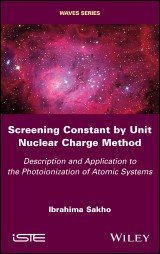Details

Screening Constant by Unit Nuclear Charge Method
Description and Application to the Photoionization of Atomic Systems1. Aufl.
|
144,99 € |
|
| Verlag: | Wiley |
| Format: | |
| Veröffentl.: | 15.02.2018 |
| ISBN/EAN: | 9781119510413 |
| Sprache: | englisch |
| Anzahl Seiten: | 416 |
DRM-geschütztes eBook, Sie benötigen z.B. Adobe Digital Editions und eine Adobe ID zum Lesen.
Beschreibungen
<p>The reader will find in this collection a clear exposition of the method of the Screen Constant by Nuclear Charge Unit which can be applied in a simple and immediate way to many fields of Physics in relation to atomic spectroscopy.</p>
<p>Foreword xi</p> <p>Preface xv</p> <p>Introduction xix</p> <p><b>Part 1 1</b></p> <p><b>Chapter 1. Different Photoionization Processes, Rydberg Series 3</b></p> <p>1.1. Photoionization processes 3</p> <p>1.2. Rydberg Series 10</p> <p><b>Chapter 2. Experimental and Theoretical Methods of Photoionization 21</b></p> <p>2.1. Experimental methods 21</p> <p>2.2. Theoretical methods 22</p> <p>2.3. Absolute photoionization cross-section 24</p> <p>2.4. Analysis of resonance energies and quantum defect 28</p> <p><b>Chapter 3. General Formalism of the Screening Constant by Unit Nuclear Charge Method </b><b>Applied to Photoionization 33</b></p> <p>3.1. Genesis of the screening constant by unit nuclear charge method 33</p> <p>3.2. Expression of the total energy of three-electron atomic systems 43</p> <p>3.3. General expressions of the resonance energies and widths of Rydberg series of multi-electron atomic systems 48</p> <p><b>Part 2. Applications in the Calculations of Energies and Natural Widths of the Resonance States of</b><br /><b>Multi-Electron Atomic Systems 55</b></p> <p>Introduction to Part 2 57</p> <p><b>Chapter 4. Application to the Calculation of Energies of Two-electron Atomic Systems (Helium-like Systems) 59</b></p> <p>4.1. Energy of the ground state of helium-like systems 59</p> <p>4.2. Energy of the excited states, 1sns 1,3Se, of helium-like systems 61</p> <p>4.3. Energy of the doubly excited symmetric states, ns2 and np2, of helium-like systems 65</p> <p>4.4. Calculation of the resonance energies and natural widths of the Rydberg series, 2 (1,0)n1Se, of the helium atom 67</p> <p>4.5. Effect of the nucleus on the accuracy of semi-empirical calculations 71</p> <p>4.6. Resonance energy of the Rydberg series, 2 (1,0)n1,3P°and 2 (1,0)n−P°, of the Li+ helium-like ion 72</p> <p>4.7. Resonance energies of the Rydberg series,1,3Se, of the Li+ helium-like ion converging toward the excitation threshold, n = 2 78</p> <p>4.8. Calculation of the energies of the Rydberg states,3 (1,1)n 1P0, of helium-like systems 80</p> <p>4.9. Physical interpretation of the angular-correlation quantum number, K 82</p> <p><b>Chapter 5. Calculating the energies of Three-electron Atomic Systems (Lithium-like Systems) 117</b></p> <p>5.1. Energy of the ground state of lithium-like systems 117</p> <p>5.2. Energy of the doubly excited states, ls2snl 2L, of lithium-like systems 119</p> <p>5.3. Energy of the doubly excited states, ls2sns 2S, of lithium-like systems 123</p> <p>5.4. Energy of the single excitation states, 1s2nl 2L???n(1 ≤?nl ≤?n3), of lithium-like systems 132</p> <p><b>Chapter 6. Application in the Resonant Photoionization of Atomic Systems of Atomic Numbers Z = 4–12 149</b></p> <p>6.1. Resonance energies of the Rydberg series, (2pns 1P°) and (2pnd 1P°), of beryllium 149</p> <p>6.2. Resonance energies of the excited states, 1s2p4 2,4L, of five-electron atomic systems (boron-like systems) 153</p> <p>6.3. Energies and widths of the Rydberg series, 2pns 1,3P°and 2pnd 1.3P°, of the beryllium-like B+ ion 164</p> <p>6.4. Energies and widths of the Rydberg series, 2pnl 1,3P°, of beryllium-like ions C2+, N3+. ….. and Ar14+ 181</p> <p>6.5. Resonance energies of the Rydberg series, 2s22p4 (1D2)ns, nd, 2s22p4 (1S0)ns, nd and 2s2p5 (3P2)np, of the Ne+ ion 206</p> <p>6.6. Energies of the Rydberg series, 2s22p2 (1D)nd (2L), 2s22p2 (1S)nd (2L), 2s2p3(5S0)np (4P) and 2s22p3 (3D)np, of the F2+ ion 222</p> <p>6.7. Energies and widths of the Rydberg series, 3pns 1.3P, 3pnd 1.3P and 3pnd 3D, of magnesium (Mg) 230</p> <p>6.8. Energies and widths of several resonance states resulting from the photoexcitation 1s →2p of the N3+ and N4+ ions 245</p> <p><b>Chapter 7. Resonant Photoionization of Sulfur (S) and Ar+, Se+, Se2+ and Kr+ Ions 255</b></p> <p>7.1. Photoionization of sulfur 255</p> <p>7.2. Photoionization of the krypton ion (Kr+) 264</p> <p>7.3. Photoionization of the Argon ion (Ar+) 270</p> <p>7.4. Resonant photoionization of the selenium ions, Se+, Se2+ and Se3+ 283</p> <p>Conclusion 319</p> <p>Appendices 325</p> <p>Appendix 1. Detailed Calculation of the Screening Constant by Unit Nuclear Charge Relative to the Ground State of Two-electron Atomic Systems 327</p> <p>Appendix 2. Formalism of Slater’s Atomic Orbital Theory 335</p> <p>Appendix 3. Modified Formalism of the Atomic Orbital Theory 341</p> <p>Bibliography 353</p> <p>Index 371</p>
<strong>Ibrahima Sakho</strong>, Assane Seck University of Ziguinchor, Senegal.
Diese Produkte könnten Sie auch interessieren:

Introduction to Focused Ion Beams

von: Lucille A. Giannuzzi, Lucille A. North Carolina State University

128,39 €















